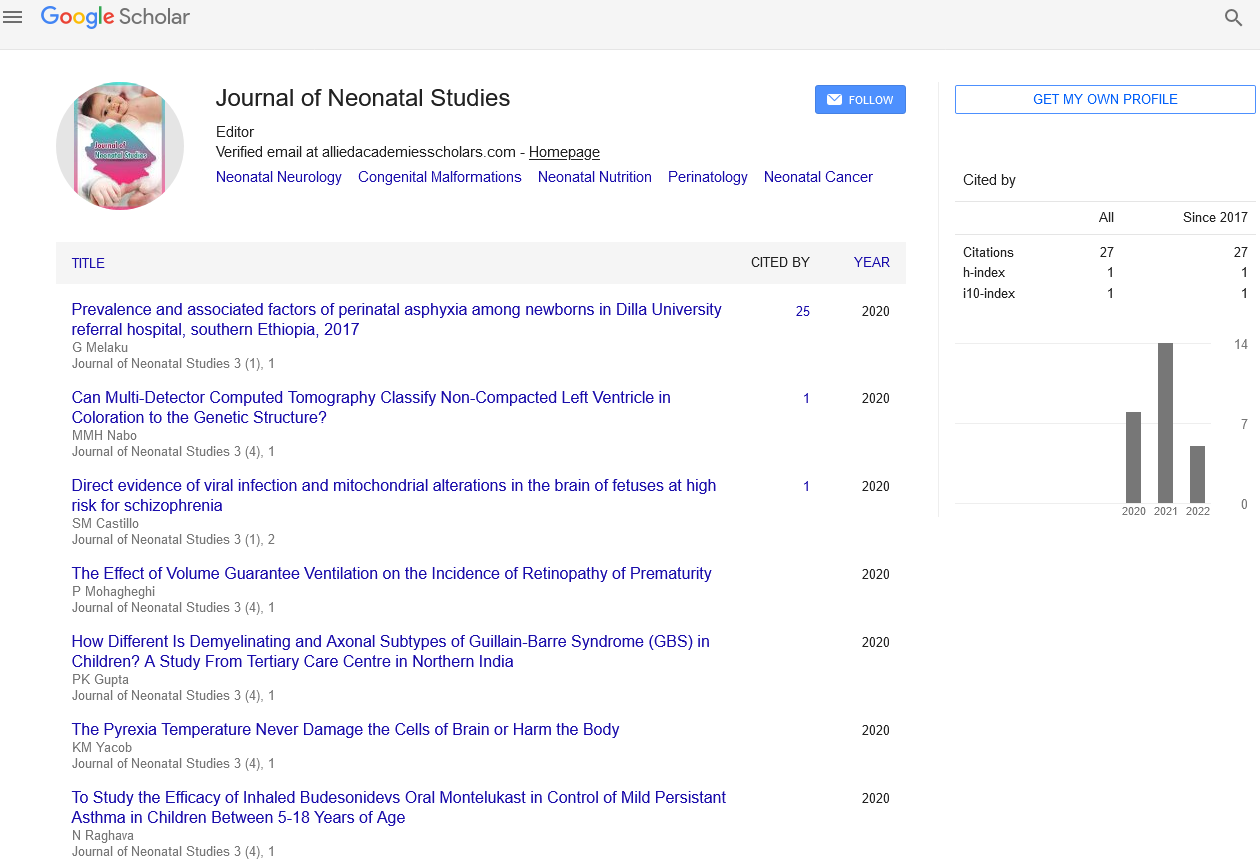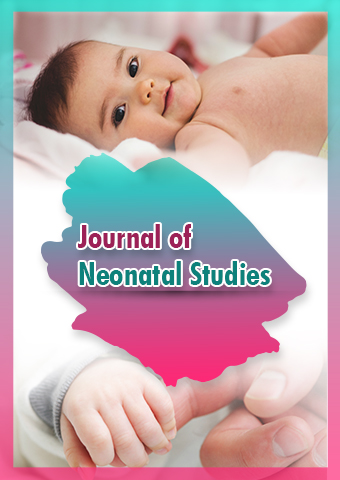Review Article - Journal of Neonatal Studies (2023) Volume 6, Issue 3
Neonatal Rheumatology: Understanding and Managing Rheumatic Conditions in Infants
Feuchtner Gudrun*
Department of Radiology, Innsbruck Medical University, 6020 Innsbruck, Austria
Department of Radiology, Innsbruck Medical University, 6020 Innsbruck, Austria
E-mail: feuchtner.gudrun@i-med.ac.edu.at
Received: 01-June-2023, Manuscript No. jns-23-103087; Editor assigned: 2-June-2023, PreQC No. jns-23- 103087(PQ); Reviewed: 15-June- 2023, QC No. jns-23-103087; Revised: 23-June-2023, Manuscript No. jns-23- 103087(R); Published: 30-June-2023; DOI: 10.37532/jns.2023.6(3).57-60
Abstract
Neonatal rheumatology is a specialized field of medicine that focuses on the diagnosis and management of rheumatic diseases in newborn infants. Rheumatic diseases in neonates encompass a broad range of conditions, including inflammatory disorders, autoimmune diseases, and systemic vasculitides. Although relatively rare, these conditions can have significant implications for the affected infants and their families. This abstract provides an overview of neonatal rheumatology, highlighting key aspects of the field, including epidemiology, clinical presentation, diagnostic approaches, and therapeutic strategies. The incidence of rheumatic diseases in neonates is relatively low, with certain conditions, such as neonatal lupus erythematosus and systemic juvenile idiopathic arthritis, being more commonly encountered. However, due to the complexity and overlap of symptoms, diagnosis in neonates can be challenging and often requires a multidisciplinary approach involving pediatric rheumatologists, neonatologists, and other specialists. The clinical presentation of rheumatic diseases in neonates varies widely, and symptoms can manifest in different organ systems, including the skin, joints, heart, and lungs. In some cases, neonates may present with non-specific signs such as fever, rash, or poor feeding, making early recognition and diagnosis crucial for appropriate management.
Keywords
Neonatal rheumatology • Rheumatic diseases • Autoimmune conditions • Inflammatory disorders • Joint diseases • Connective tissue disorders • Neonates • Early detection • Diagnosis • Management • Long-term outcomes • Quality of life • Premature surgery • Radiology • Ultrasound
Introduction
Neonatal rheumatology is a specialized field of medicine that focuses on the diagnosis, treatment, and management of rheumatic conditions in newborns and infants. Rheumatic diseases encompass a wide range of conditions that affect the joints, muscles, bones, and connective tissues. While these conditions are commonly associated with adulthood, they can also occur in infants, albeit with some unique characteristics. Neonatal rheumatology aims to provide early intervention and comprehensive care to ensure optimal outcomes for these vulnerable patients. In this article, we will explore various aspects of neonatal rheumatology, including common conditions, diagnostic methods, treatment options, and the importance of a multidisciplinary approach [1].
Neonatal rheumatology is a specialized branch of medicine that focuses on the diagnosis and treatment of rheumatic diseases in newborn infants. Rheumatic diseases encompass a wide range of autoimmune and inflammatory conditions that affect the joints, muscles, and connective tissues of the body. While these diseases commonly manifest in older children and adults, they can also present in neonates, posing unique diagnostic and management challenges. Neonatal rheumatology aims to provide early detection, accurate diagnosis, and optimal care for these vulnerable patients, improving their long-term outcomes and quality of life [2, 3].
Neonatal rheumatology is a specialized branch of medicine that focuses on the diagnosis and treatment of rheumatic diseases in newborns and infants. Rheumatic diseases are a diverse group of conditions that affect the joints, muscles, and connective tissues, resulting in inflammation and pain. While these conditions are commonly associated with adults, they can also occur in the early stages of life, affecting the health and well-being of newborns. Neonatal rheumatology addresses a wide range of conditions, including but not limited to juvenile idiopathic arthritis, systemic lupus erythematosus, dermatomyositis, and vasculitis [4].
These conditions present unique challenges when they manifest in newborns due to the complexities of diagnosis and treatment in such young patients. Diagnosing rheumatic diseases in neonates requires a multidisciplinary approach, involving pediatric rheumatologists, neonatologists, and other healthcare professionals. Symptoms may vary and can be challenging to recognize in newborns, as they often present with nonspecific signs such as fever, irritability, poor feeding, and failure to thrive. The identification of specific diagnostic markers, as well as an understanding of the distinct clinical manifestations in this age group, is crucial for timely and accurate diagnosis [5].
In this rapidly evolving field, the collaboration between pediatric rheumatologists, neonatologists, and researchers is crucial to further enhance our understanding of the underlying mechanisms of neonatal rheumatic diseases, refine diagnostic criteria, and develop innovative treatment options. By focusing on early detection, accurate diagnosis, and effective management, neonatal rheumatology aims to provide the best possible outcomes for the youngest and most vulnerable patients affected by rheumatic diseases [6, 7].
Discussion
Common rheumatic conditions in neonates
Although rheumatic conditions are less prevalent in neonates compared to adults, there are several disorders that can affect newborns. Some of the most commonly encountered conditions include:
Juvenile idiopathic arthritis (JIA): JIA is a group of chronic inflammatory joint diseases that can manifest in infancy. It presents with symptoms such as joint swelling, pain, and stiffness. Systemic JIA, the most severe form, can also cause fever, rash, and inflammation in internal organs.
Neonatal lupus erythematosus (NLE): NLE is an autoimmune condition that can occur in infants born to mothers with autoimmune diseases, such as Systemic Lupus Erythematosus (SLE). NLE can cause a variety of symptoms, including skin rashes, liver abnormalities, and congenital heart block.
Neonatal dermato myositis (DM): DM is a rare inflammatory disease that affects the skin and muscles. In neonates, it can present with muscle weakness, characteristic skin rashes, and sometimes even respiratory distress [8].
Hyper-IgM syndrome: This is a primary immunodeficiency disorder characterized by low levels of Immunoglobulin (Ig) class-switched antibodies. It can lead to recurrent infections and increased susceptibility to opportunistic organisms.
Chronic recurrent multifocal osteomyelitis (CRMO): CRMO is a rare auto-inflammatory disorder characterized by recurring episodes of bone pain and inflammation. It can affect multiple sites in the body, and its symptoms may overlap with those of infections.
Diagnosis of neonatal rheumatic conditions
Diagnosing rheumatic conditions in neonates can be challenging due to their unique clinical presentations and the limited ability of infants to communicate their symptoms. Neonatal rheumatologists employ a combination of clinical evaluation, laboratory tests, and imaging studies to reach an accurate diagnosis. Some of the diagnostic methods commonly used include:
Clinical assessment: Rheumatologists carefully examine the infant for signs of joint inflammation, muscle weakness, skin rashes, and other specific symptoms associated with different conditions.
Blood tests: Various laboratory tests are performed to assess the levels of inflammatory markers, autoantibodies, and specific antibodies associated with rheumatic diseases [9].
Imaging studies: X-rays, ultrasound, and MRI scans may be used to evaluate joint or bone abnormalities, assess organ involvement, and aid in the differential diagnosis.
Genetic testing: In certain cases, genetic testing may be necessary to identify rare genetic disorders with rheumatic manifestations.
Treatment and management approaches
The treatment and management of neonatal rheumatic conditions require a multidisciplinary approach involving neonatologists, pediatric rheumatologists, physical therapists, occupational therapists, and other healthcare professionals. The primary goals of treatment include relieving symptoms, controlling inflammation, preserving joint function, and improving the infant’s overall well-being [10].
Conclusion
Neonatal rheumatology is a specialized field of medicine dedicated to the diagnosis, treatment, and management of rheumatic conditions that affect infants during the first months of life. This branch of rheumatology focuses on understanding and addressing the unique challenges presented by rheumatic diseases in neonates, who have distinct physiological characteristics and immune systems compared to older children and adults.
Neonatal rheumatology encompasses a range of conditions, including but not limited to neonatal lupus, juvenile idiopathic arthritis, Kawasaki disease, and systemic juvenile idiopathic arthritis. These conditions can cause significant morbidity and mortality if left untreated or misdiagnosed, underscoring the importance of early detection and intervention. Advances in medical knowledge, diagnostic techniques, and treatment options have significantly improved outcomes for neonates with rheumatic diseases. Timely and accurate diagnosis, often requiring collaboration between neonatologists, pediatric rheumatologists, and other specialists, is crucial in providing appropriate care and optimizing long-term outcomes. Despite the progress made in neonatal rheumatology, there are still many challenges and areas of ongoing research. Additionally, a multidisciplinary approach is essential in neonatal rheumatology, involving not only medical professionals but also physical therapists, occupational therapists, and other healthcare providers. This holistic approach ensures comprehensive care that addresses the physical, emotional, and developmental needs of neonates with rheumatic diseases.
Further understanding of the underlying mechanisms of rheumatic diseases in neonates, development of targeted therapies with fewer side effects, and optimization of diagnostic techniques are among the important areas of investigation.
Neonatal rheumatology plays a vital role in the early identification, management, and treatment of rheumatic diseases in infants. Through ongoing research, collaboration, and advancements in medical care, we can continue to improve outcomes and provide a better quality of life for neonates affected by these conditions.
Acknowledgement
None
Conflict of Interest
None
References
- Michels A, Gottlieb P. Autoimmune polyglandular syndromes. Nature Reviews Endocrinology. 6, 270-277 (2010).
- Dittmar M, Kahaly GJ. Polyglandular autoimmune syndromes: immunogenetics and long-term follow-up. J Clin Endocrinol Metab. 88, 2983-2992 (2003).
- Eisenbarth GS, Gottlieb PA Autoimmune polyendocrine syndromes. New England Journal of Medicine. 350, 2068-2079 (2004).
- Arlt W. The approach to the adult with newly diagnosed adrenal insufficiency. J Clin Endocrinol Metab. 94, 1059-1067 (2009).
- Erichsen MM, Løvas K, Skinningsrud B et al. Clinical, immunological, and genetic features of autoimmune primary adrenal insufficiency: observations from a Norwegian registry. J Clin Endocrinol Metab. 94, 4882-4890 (2009).
- Betterle C, Lazzarotto F, Presotto F et al. Autoimmune polyglandular syndrome Type 2: the tip of an iceberg? Clin Immunol. 137, 225-233 (2004).
- Tsokos G Systemic lupus erythematosus. N Engl J Med. 365, 2110-2121 (2011).
- Petri M, Orbai AM, Alarcón GS et al. Derivation and validation of the Systemic Lupus International Collaborating Clinics classification criteria for systemic lupus erythematosus. Arthritis Rheumatol. 64, 2677 (2012).
- Arroyo Ávila M, Vilá LM. Cardiac tamponade in a patient with mixed connective tissue disease. J Clin Rheumatol. 21 42-45 (2015).
- LeWinter MM. Acute pericarditis. N Engl J Med 371, 2410-2416 (2014).
Indexed at, Crossref, Google Scholar
Indexed at, Crossref, Google Scholar
Indexed at, Crossref, Google Scholar
Indexed at, Crossref, Google Scholar
Indexed at, Crossref, Google Scholar
Indexed at, Crossref, Google Scholar
Indexed at, Crossref, Google Scholar
Indexed at, Crossref, Google Scholar
Indexed at, Crossref, Google Scholar

